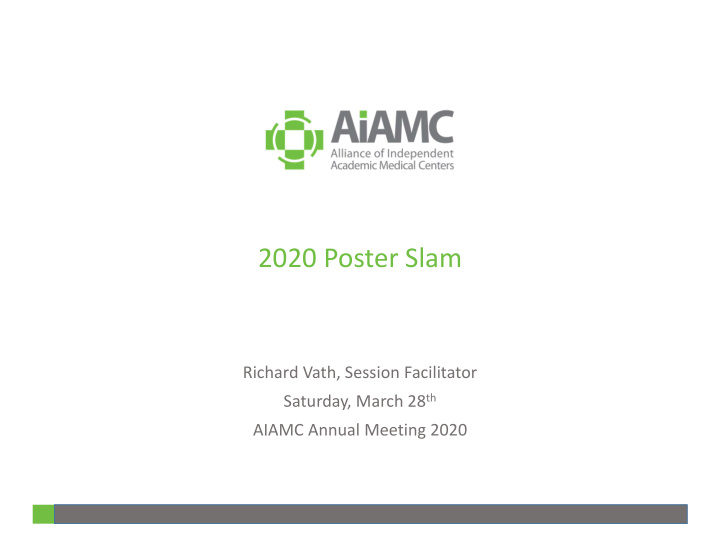



2020 Poster Slam Richard Vath, Session Facilitator Saturday, March 28 th AIAMC Annual Meeting 2020
Poster Slam Top Four Poster Abstracts Received Each Presentation: > Up to Five (5) Slides > Up to Eight (8) Minute Presentation > Followed by Two (2) Minutes Q & A > Each Presentation May Not Exceed Ten (10) Minutes NEW THIS YEAR: Everyone in Audience is Invited to Vote on Winner > https://www.surveymonkey.com/r/POSTERSLAMSCORE > (This link also appears on website and meeting app) Winner Announced at Close of Meeting
An OSCE Opioid Management Case: Correlations with Residents’ Systems-Based Practice Milestones Tsveti Markova, MD, R. Brent Stansfield, PhD, Heidi Kenaga, PhD Office of Graduate Medical Education, Wayne State University AIAMC 2020 Annual Meeting March 27, 2020
OSCE at WSU 4 SP cases, 1 OSHE Handoff simulation KEECC: Kalamazoo Essential Elements of Communication Checklist > 7 items measuring communication skills > SPs rate performance and give feedback > Residents self-rate performance and review video PGY1 and 2 across 7 programs > 2 cohorts • August, 2018 ( N = 50) • August, 2019 ( N = 51)
New Case: Morgan Tempo 59-year-old female Follow-up for chronic lower back pain Finishing 2-month medical leave > Elementary school teacher > Goes back to work in 2 days Neighbor gave her some Norco pills > She wants more Does not want physical therapy or steroids
Hypothesis: SP KEECC ratings will predict residents’ SBP milestones ratings (linear regression): > SBP1: Coordinates patient care within settings > SBP2: Works in interdisciplinary teams > SBP3: Advocates for cost-effective care 2018 Year-end SBP milestones SBP1 SBP2 PGY1 PGY2 SBP3 OSCE OSCE
Results: Year 1: No correlations Year 2: Two of the three correlations > SBP1: Coordinates patient care within settings > SBP2: Works in interdisciplinary teams > SBP3: Advocates for cost-effective care 2018 Year-end SBP milestones R 2 = .39, p < .001 SBP1 R 2 = .32, p < .001 SBP2 PGY1 PGY2 SBP3 OSCE OSCE
Conclusions After 1 year of training > SBP skills are measurable in OSCE > SP ratings agree with CCC milestones ratings At matriculation > SP ratings do not predict CCC milestones > Some SBP performance appears to be learned OSCE is useful for training and measurement
You Can Lead a Horse to W ater but… Do Learners Access W eb Resources Recom m ended During F2 F Educational Sessions? Deborah Simpson PhD @debsimpson3 Kathryn Denson, MD @kdenson2 Steven Denson, MD Amanda Szymkowski @GerFastFacts Edmund Duthie, MD Michael Malone, MD @MichaelMaloneMD Presentation Sat 3.28.2020 Austin
OUR QUESTION B ACKGROUND •Digital learning resources during F2F sessions •Some subjects – Geriatrics - are complex yet limited time 2015 Geriatric Fast Facts (GFFs) as mobile enabled website o GFFs “Fast”= Short for point of care education, evidence o based, searchable O UR Q UESTION •Are GFF’s accessed when referenced? www.geriatricfastfacts.com
METHODS Identified 3 F2F Sessions • Same Teachers • Same Topic Highlighted a Specific GFF • #78 Dementia Caregiver Resources • 30-60 Minutes F2F (CME, Residents, APs) Data: Google Analytics Targeted GFF • Session Day & ± 1 Day
RESULTS: Google Analytics Pre Day of Post Conclusions 4 109 2 1. Learners DO 2 34 43 access web-based resources 5 highlighted in F2F 520 6 79 85 45 class & HO’s • Day of • Increased Post 4 2. 1st visit takes 33 36 2 138 1 Time 3. R EC : Make it EASY # Site Unique # New Users # Unique GFF Avg Session # Pgs Viewed # Pg Views to access Users (1st Visit) #78 Time (Min) in Session (other GFFs)
Questions? Comments? @GerF astF ac ts
Teaming to Advocate for Rural Healthcare Education across the Micro to Macro Continuum Heidi Duncan, MD Physician Director Healthcare Policy AIAMC Poster Slam March 28,2020 www.billingsclinic.com Health Care, Education and Research
US Population Bubble Map
The mission of our Residency is that our graduates will be experts in the care of complex medically ill patients in rural environments.
Fund the Gap: Helmsley CMS Interpretation of Foundation language in the Affordable Care Act Resulted in Residents not being able to go to Critical Access hospitals Explain the Issue: Regulatory Fix Senator Tester Advocated with 2 CMS directors and administrations. Comment letters sent. Legislative Fix? Provided bill language to fix CMS Administrator Verma problem and looked proposed regulatory changes. for co-sponsors Language from letters used. Other organizations jumped on board to support fix
Lessons Learned • On the legislative side could have communicated with organizations like the AIAMC to support legislative changes • Support from philanthropic organizations is critical to support innovation until • Leverage people/groups to make comments on proposed regulations: Volume Matters!
A novel community-based psychiatry residency program: A collaborative and inter-institutional approach Chanteau Ayers, JD Director of Medical Education Poster Slam 3/28/2020
Community-based Psychiatry Residency Program BACKGROUND • There is a shortage of psychiatry and related training programs in the U.S. • This gap in provider coverage is more pronounced in rural regions. OBJECTIVE : To describe actions taken to create a collaborate psychiatry residency program sponsored by two community- based graduate medical education institutions.
Community-based Psychiatry Residency Program STEPS In 2016, the state of Iowa solicited grant applications for development or expansion of Family Medicine or Psychiatry Programs. Two Midwestern sponsoring institutions collaborated to submit a joint application for development of a psychiatry residency program. Funding application accepted and ACGME joint institutional sponsorship acquired.
Community-based Psychiatry Residency Program STRUCTURE: Program: Four resident slots per year with four-year training curriculum. Joint business entity formed titled: UnityPoint Broadlawns Psychiatry Education Foundation. Board of Governance w/ representation from each institution: -CEOs and senior administrators; -Directors of Medical Education; -Residency program directors; -Faculty. Program administered in 50:50 partnership
Community-based Psychiatry Residency Program
Recommend
More recommend